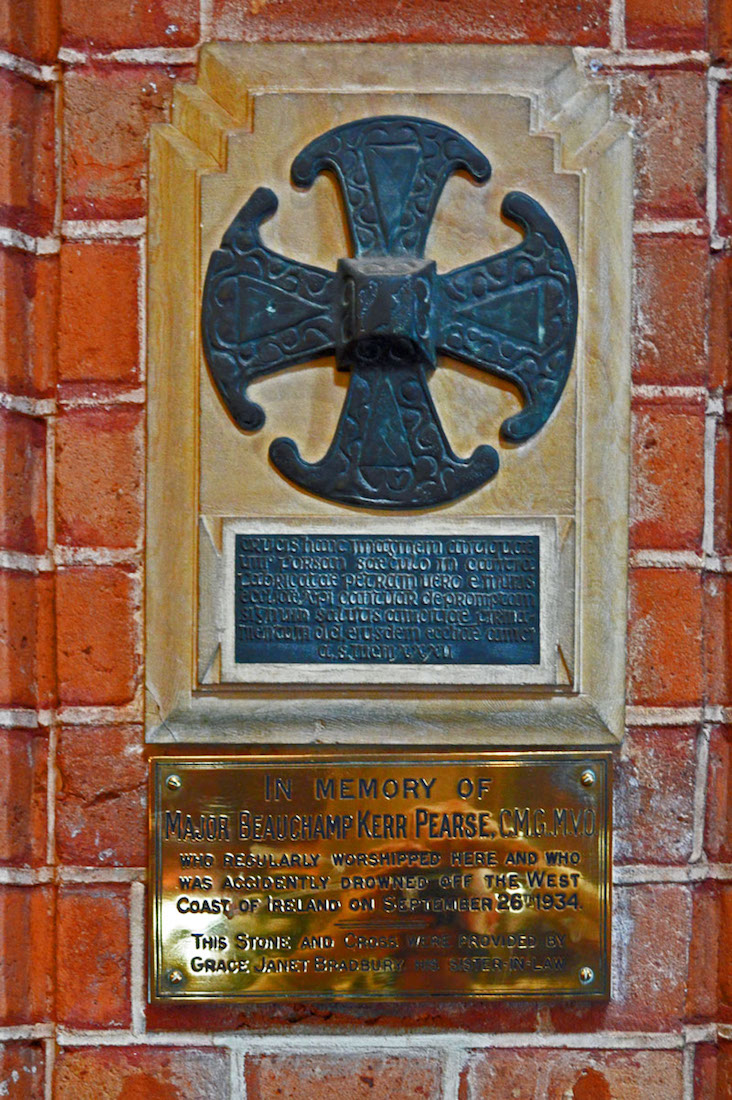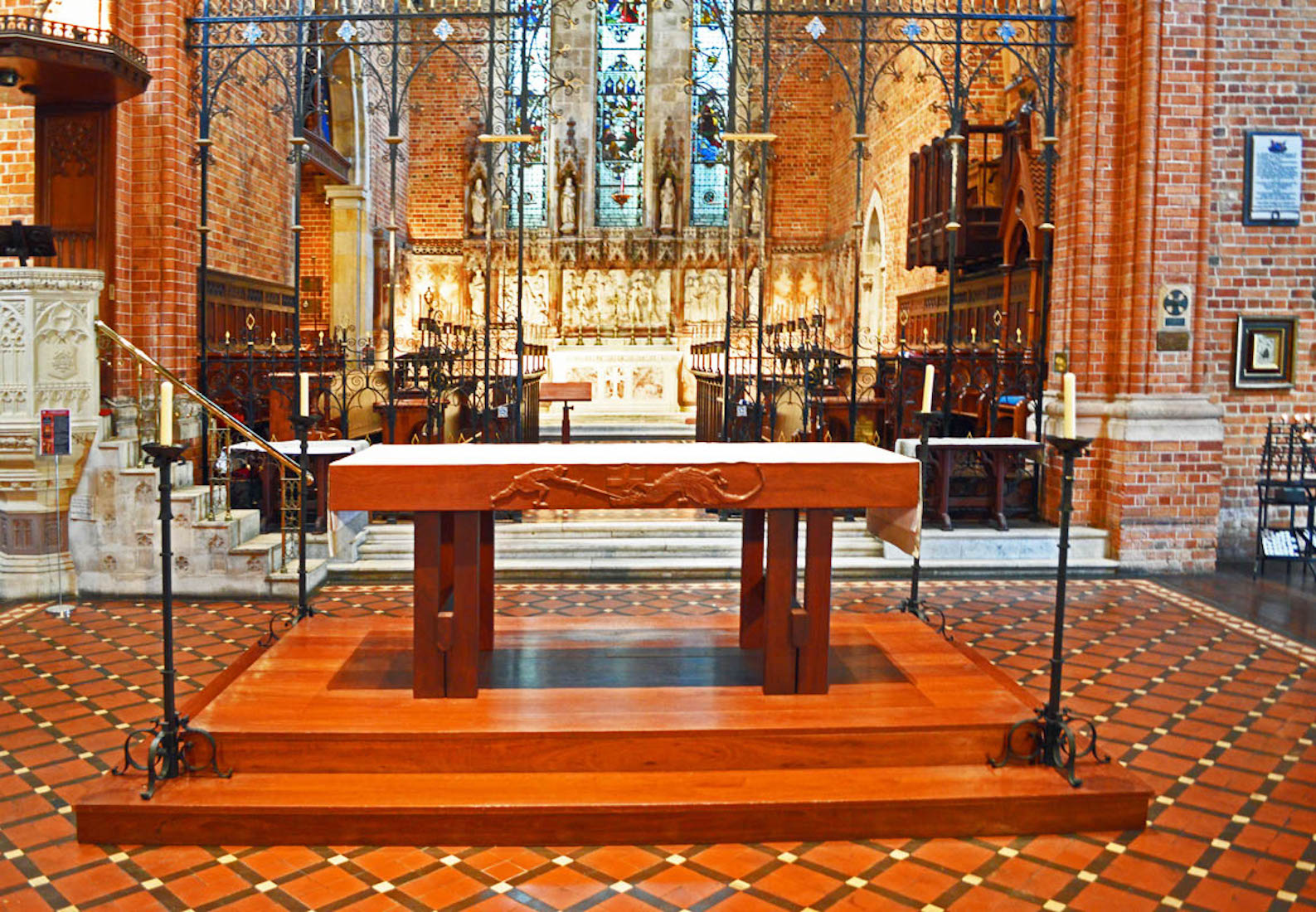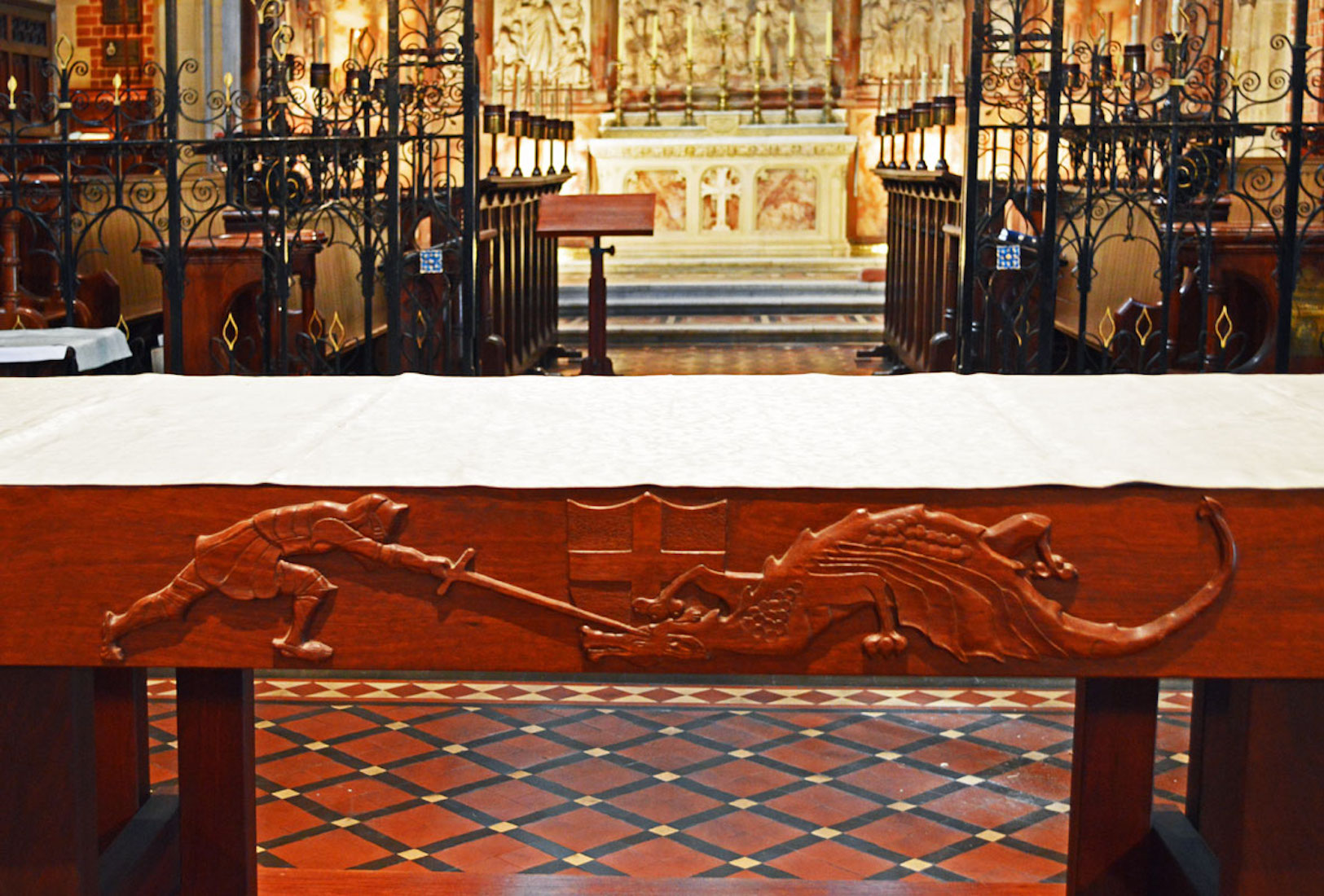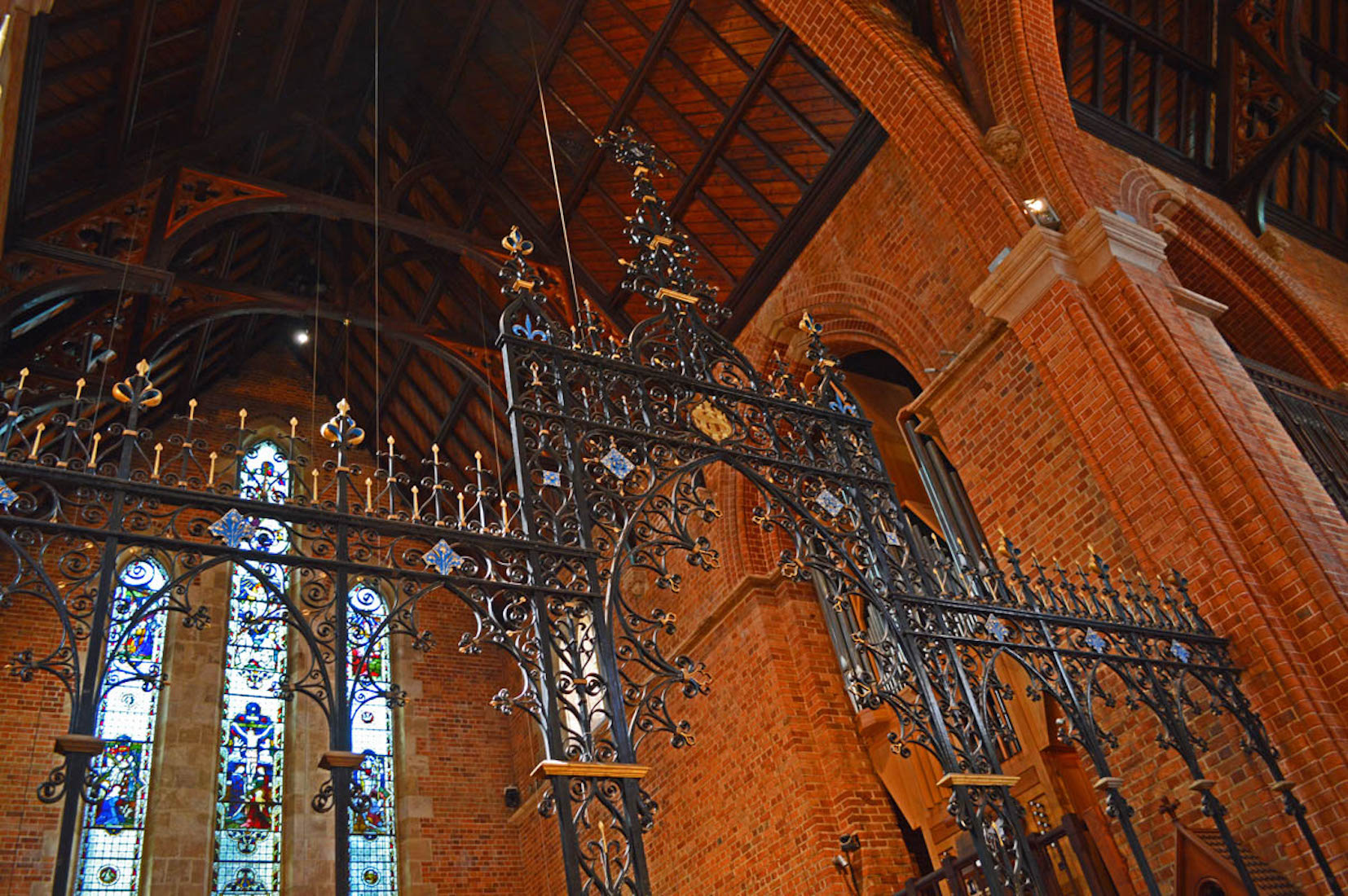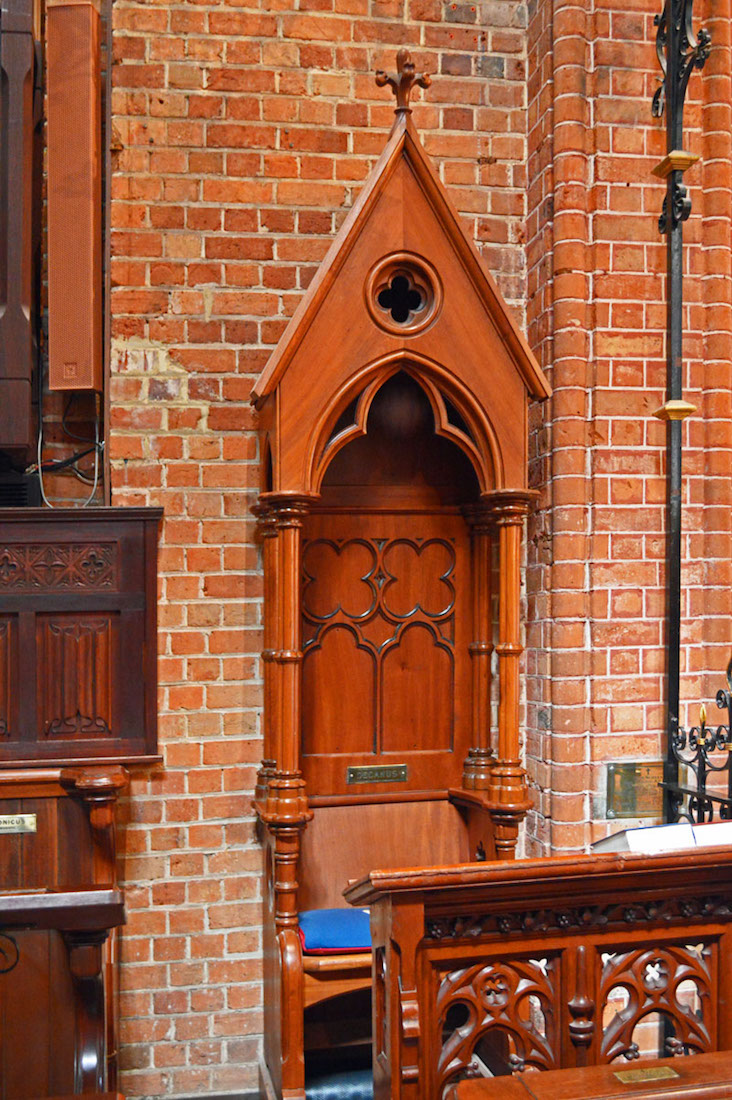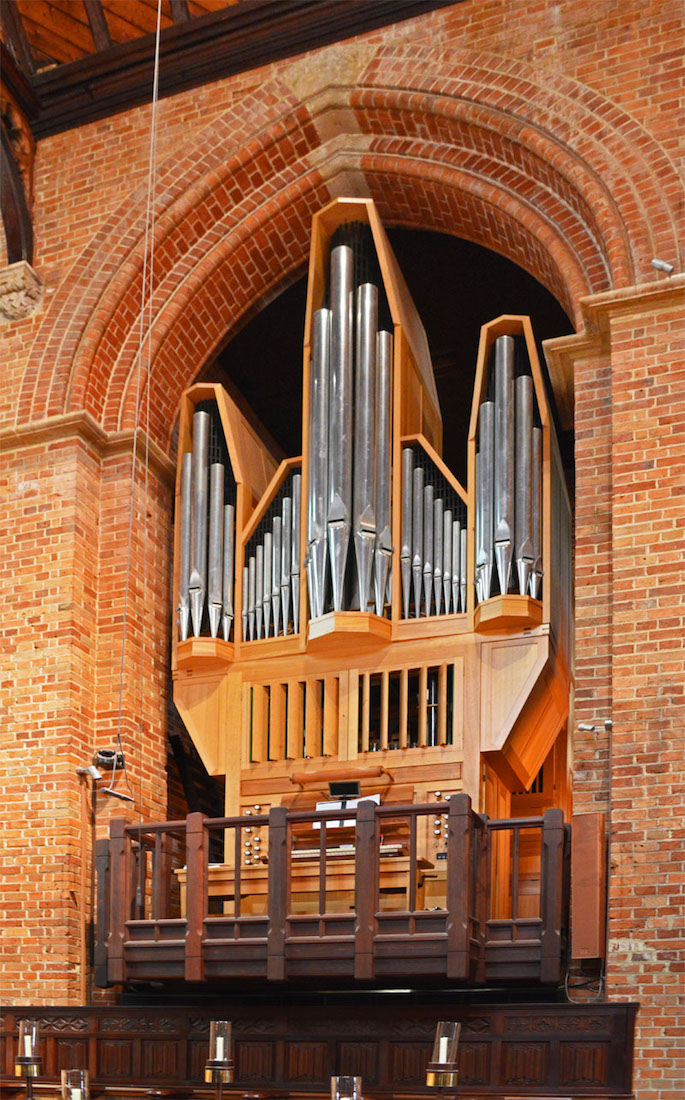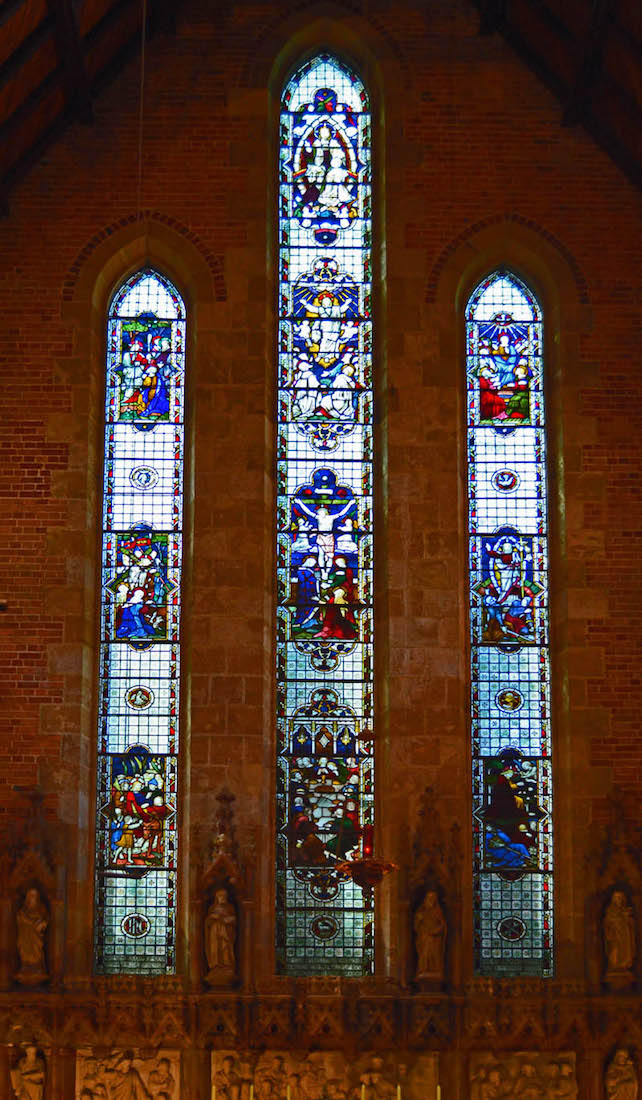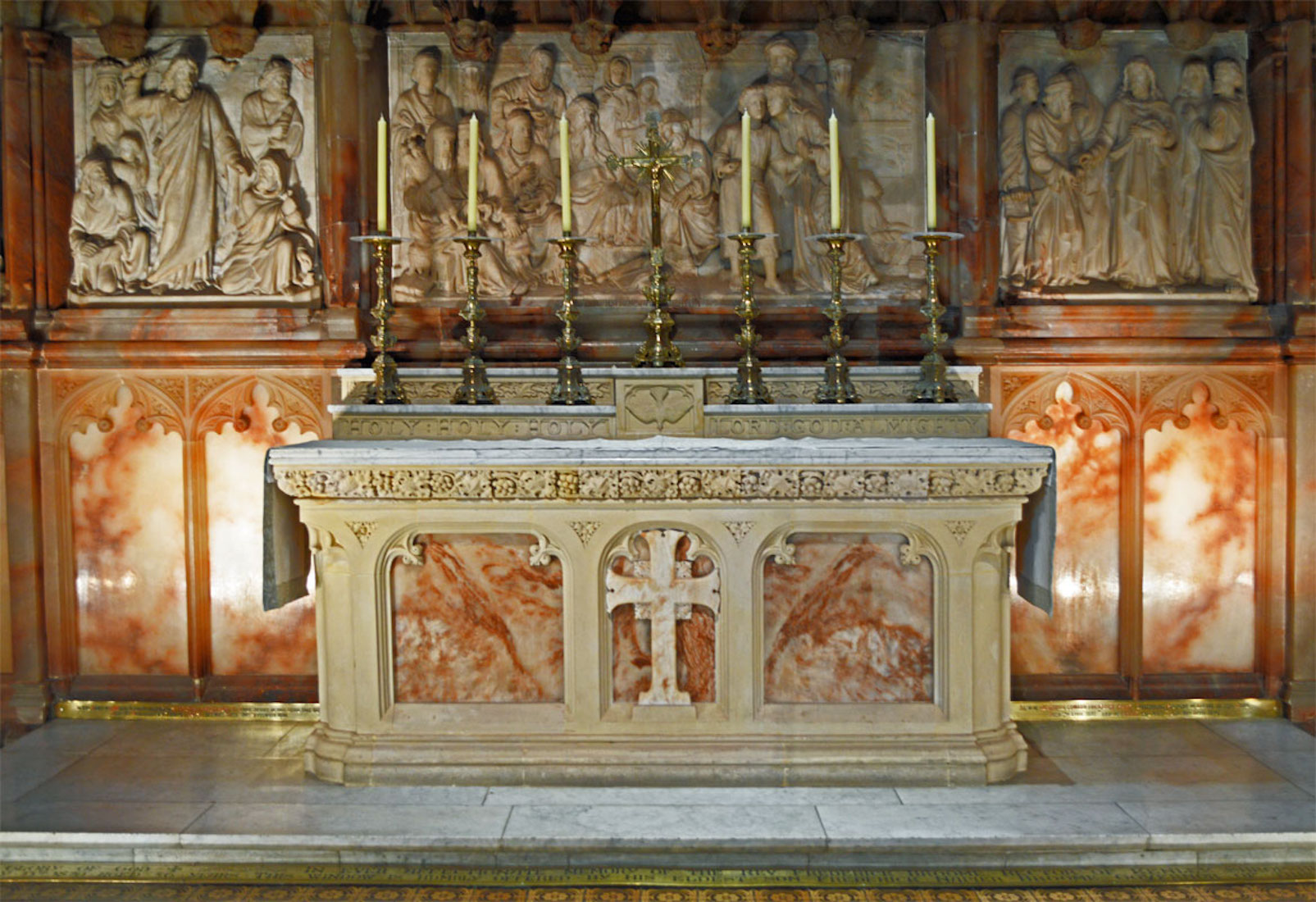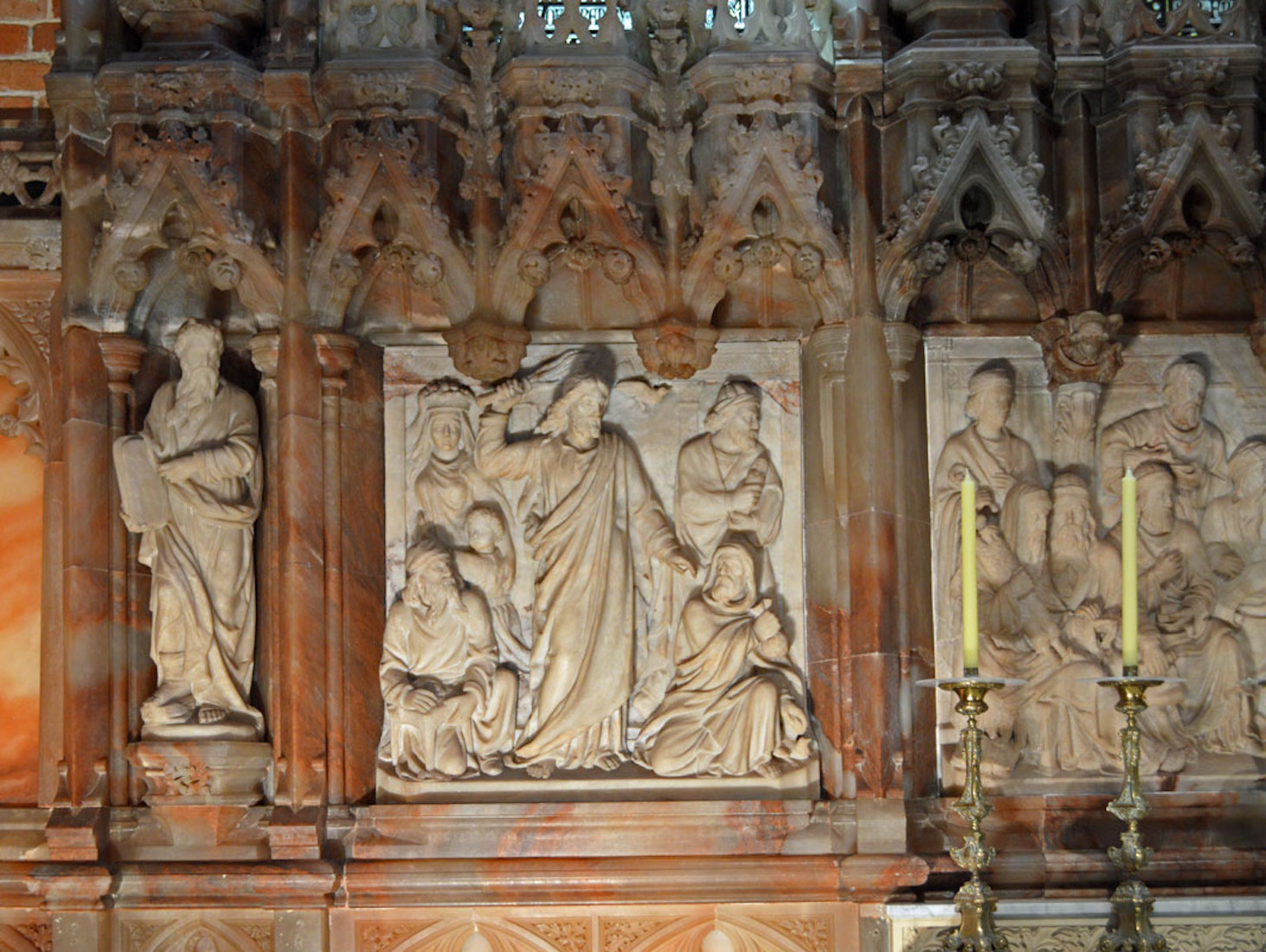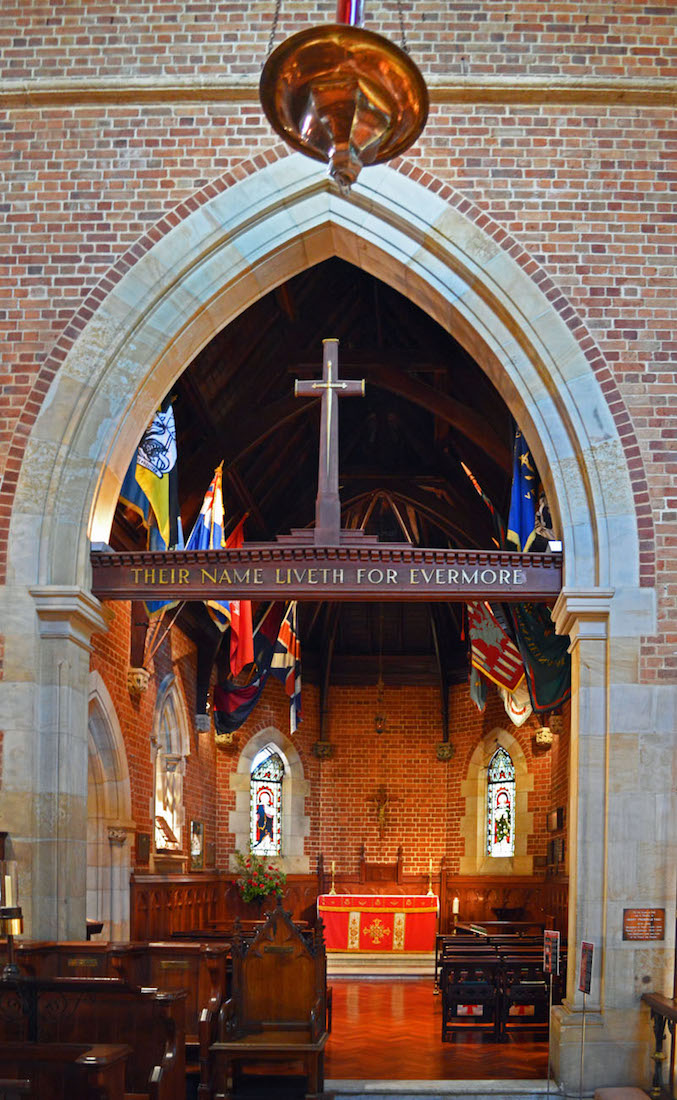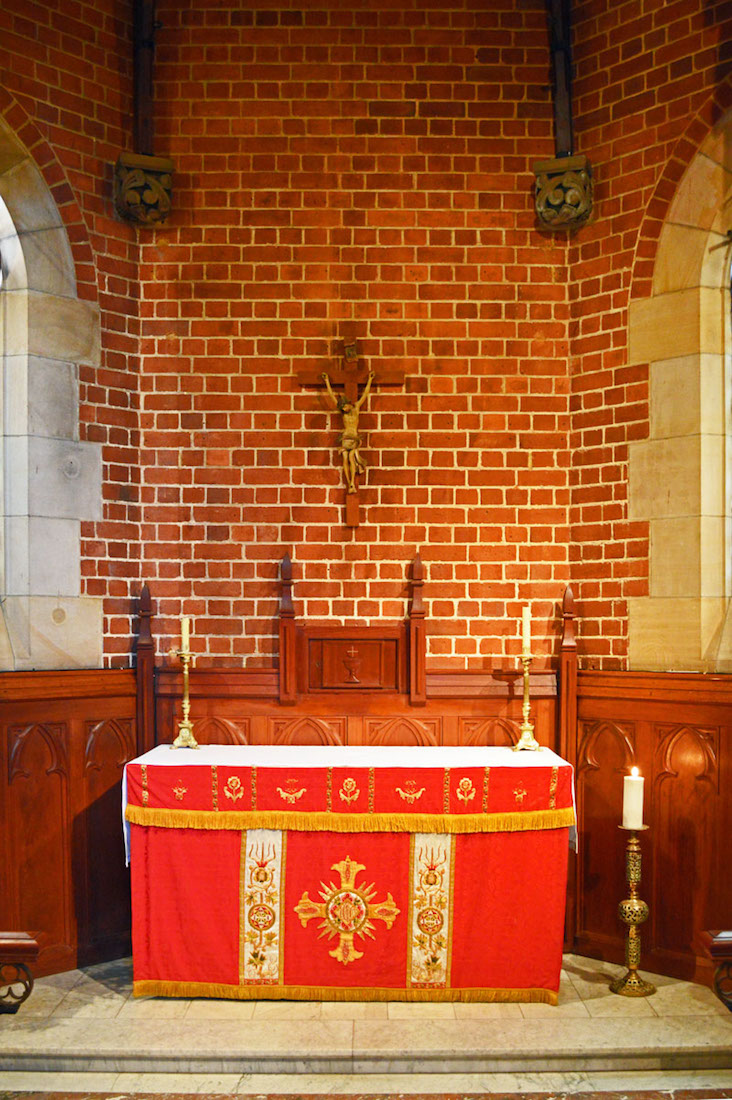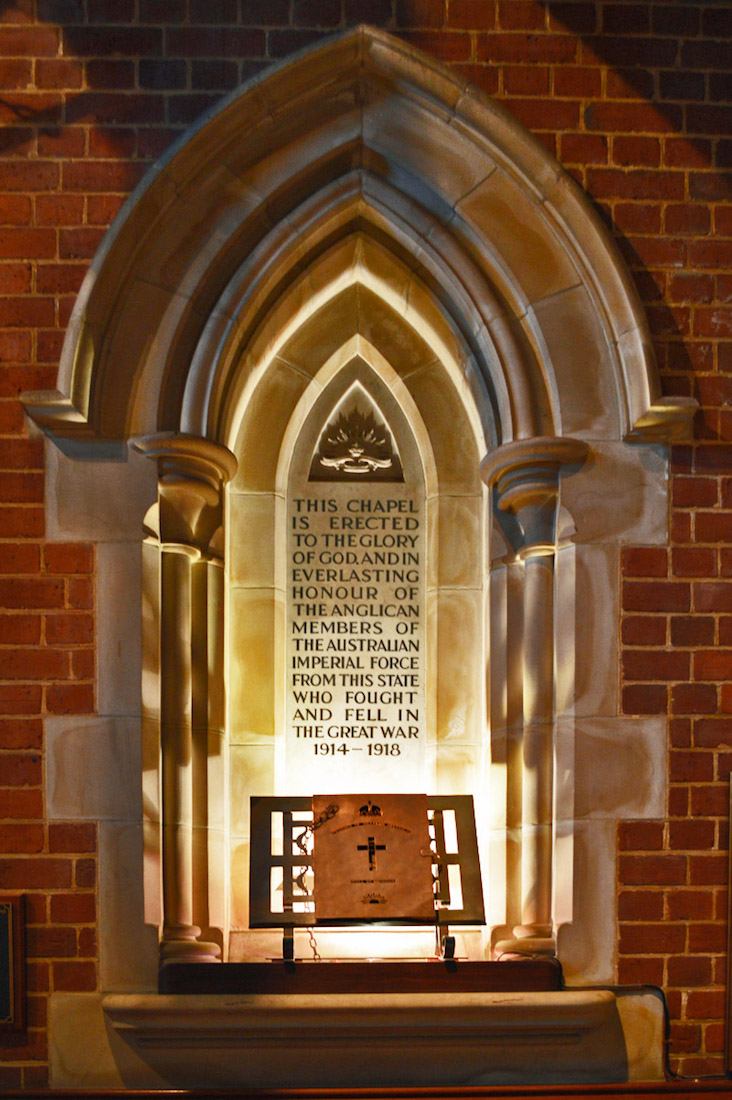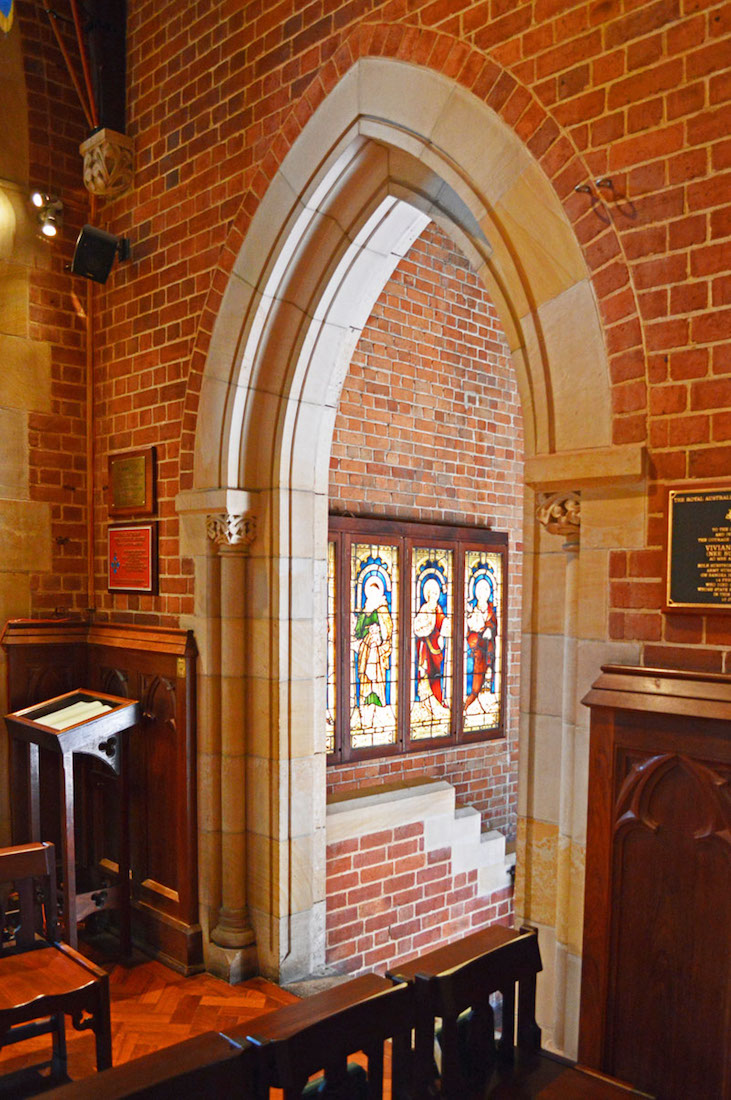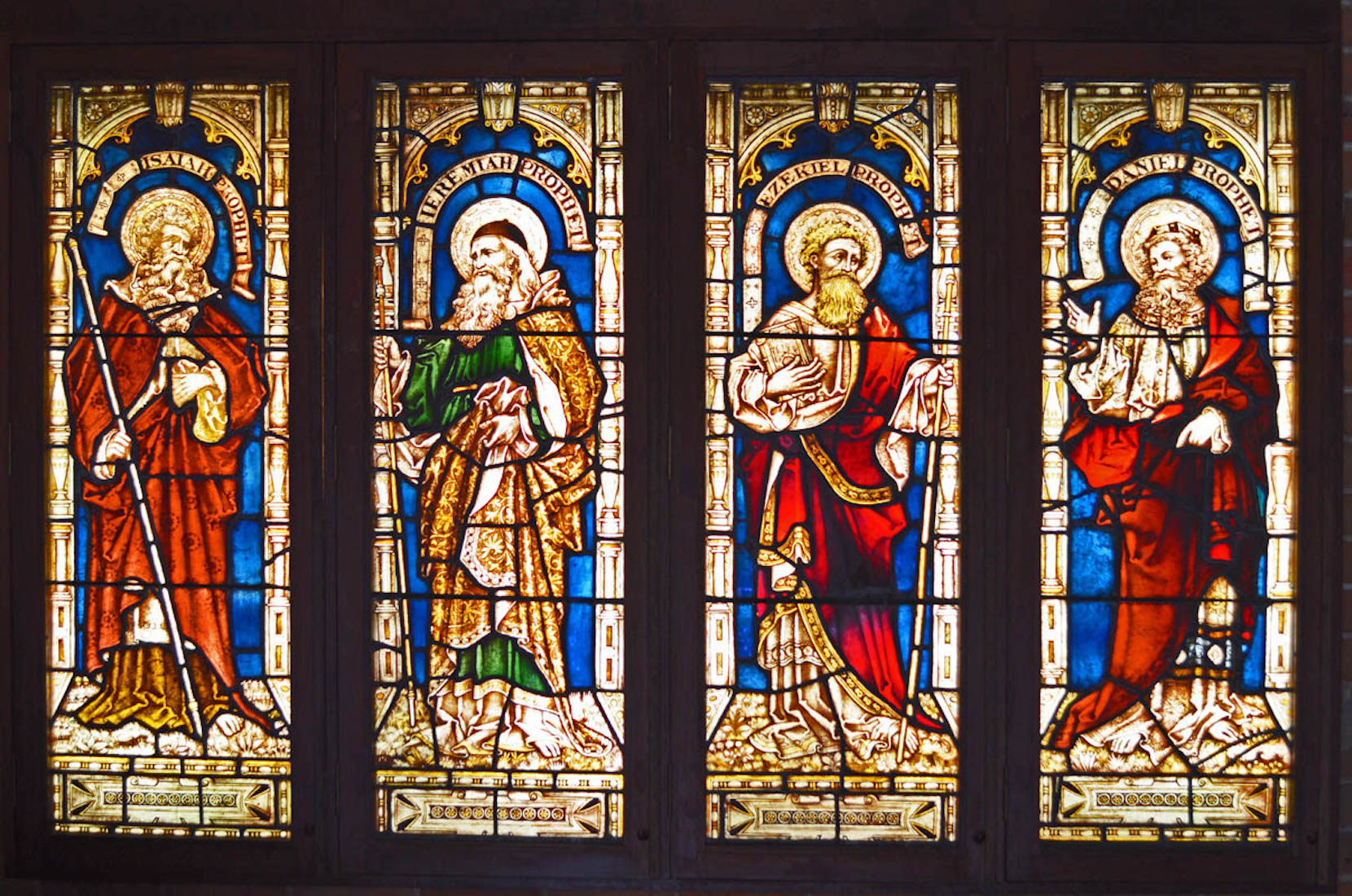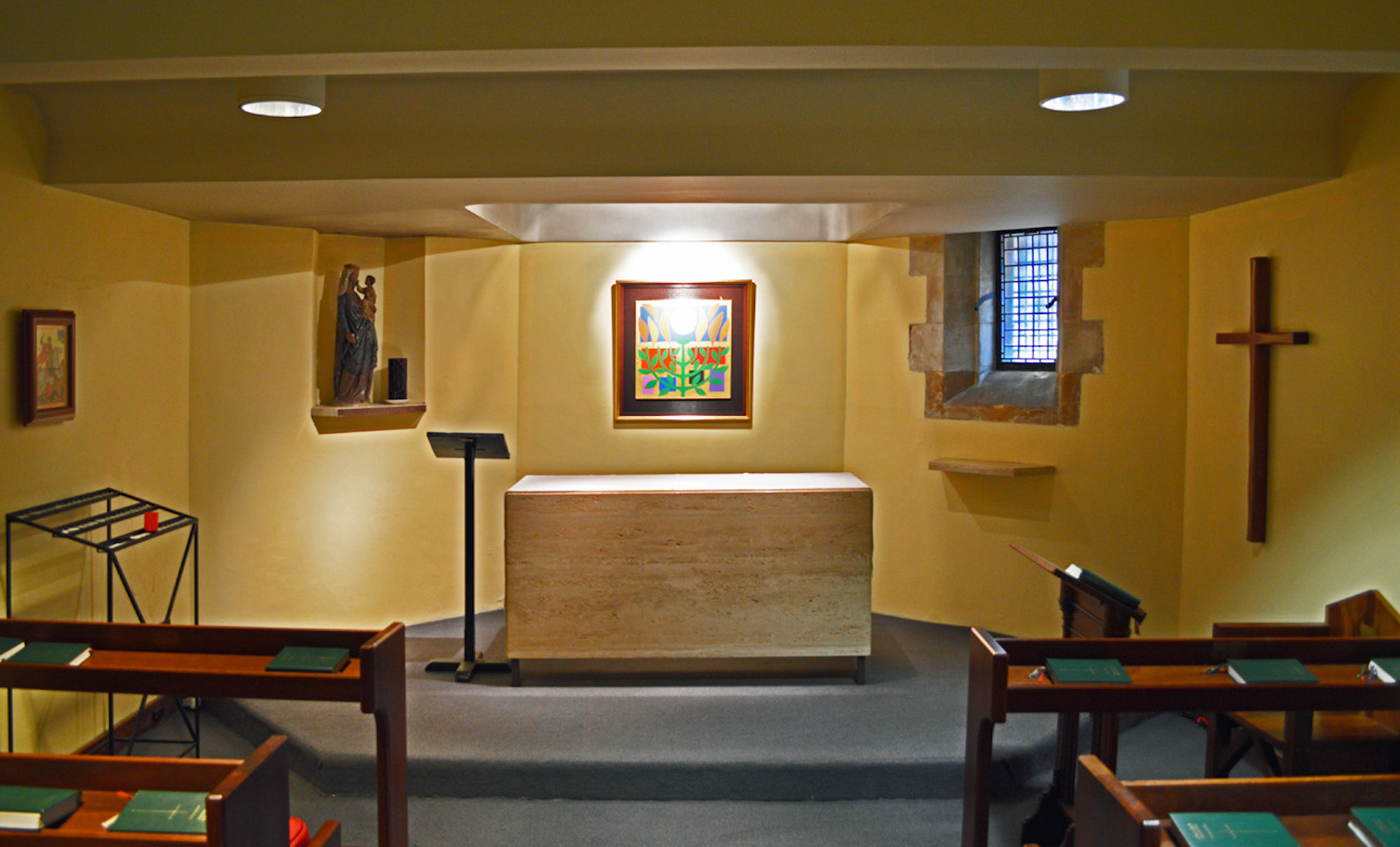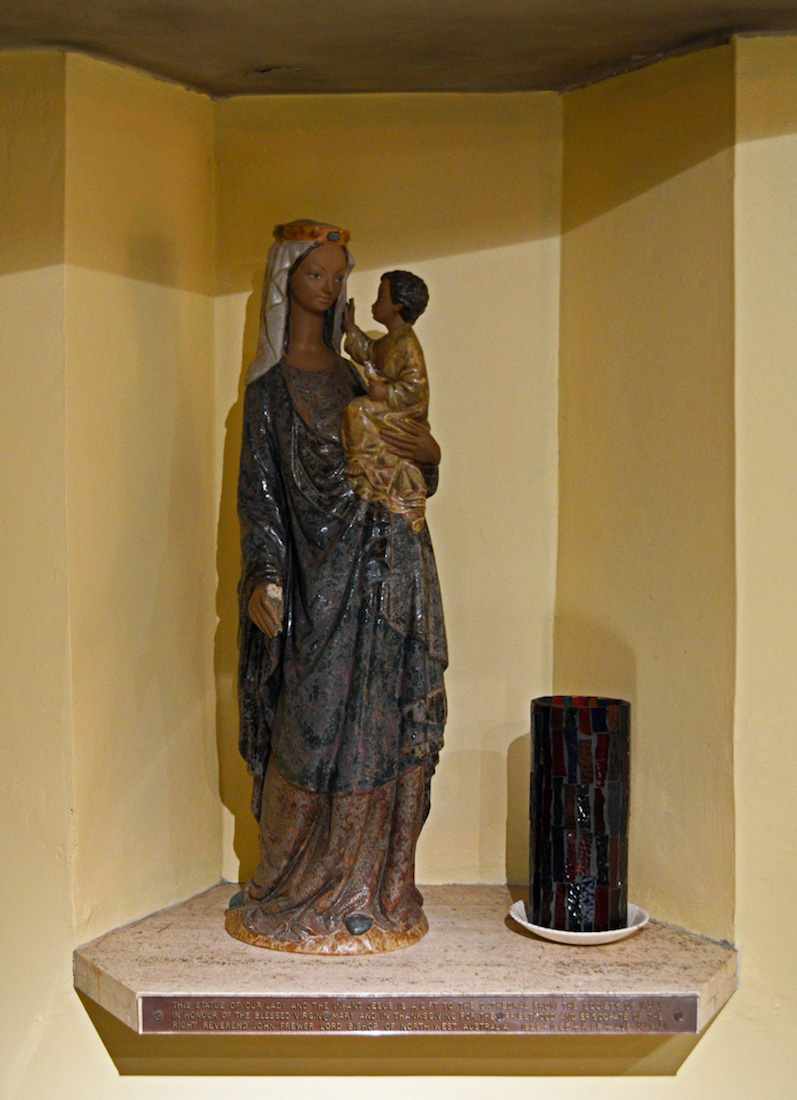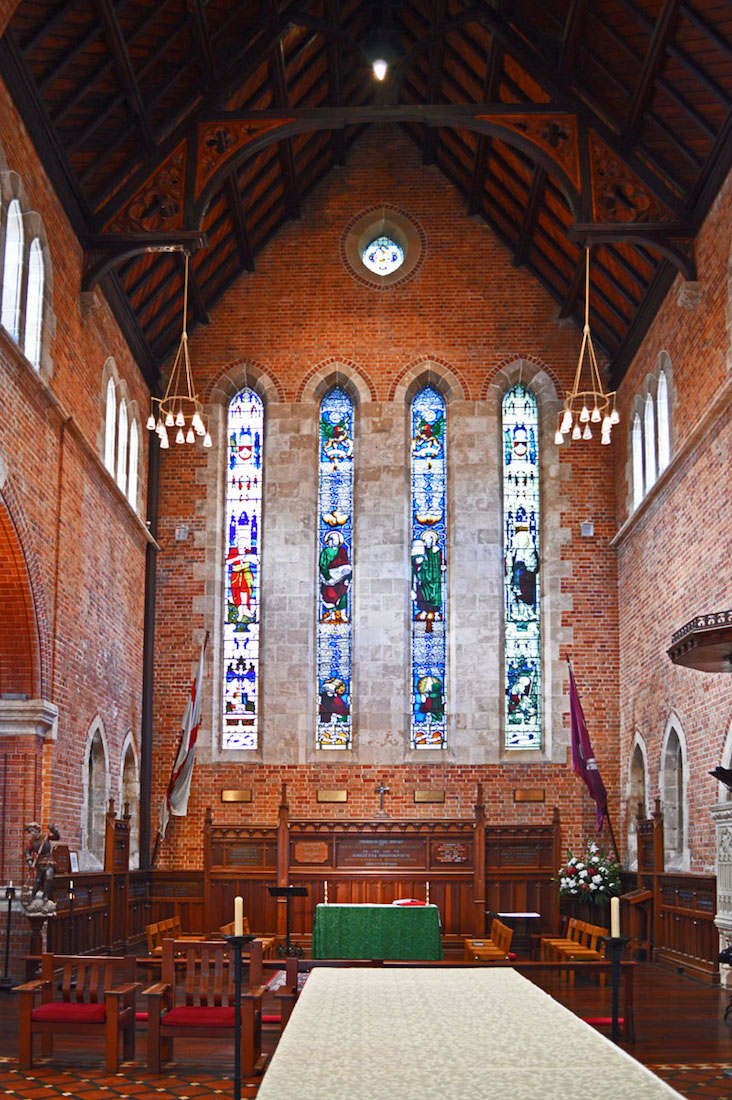21. SOUTH TRANSEPT ROSE WINDOW

The rose window in the South transept is called the Dorcas Window. Dorcas was a woman recorded in the Acts of the Apostles (Acts 9:36): ‘Now there was in Joppa a certain disciple named Tabitha, which by interpretation is called Dorcas: this woman was full of good works and alms deeds which she did’. The window was given in 1908 in memory of Mary Elizabeth Moore, a tireless worker in the service of others. The top figure is that of Dorcas. At the bottom of the window is the figure of Charity. The four remaining figures carry scrolls: one reads ‘Handmaiden of the Lord’. PLAN
22. SOUTH TRANSEPT WINDOW
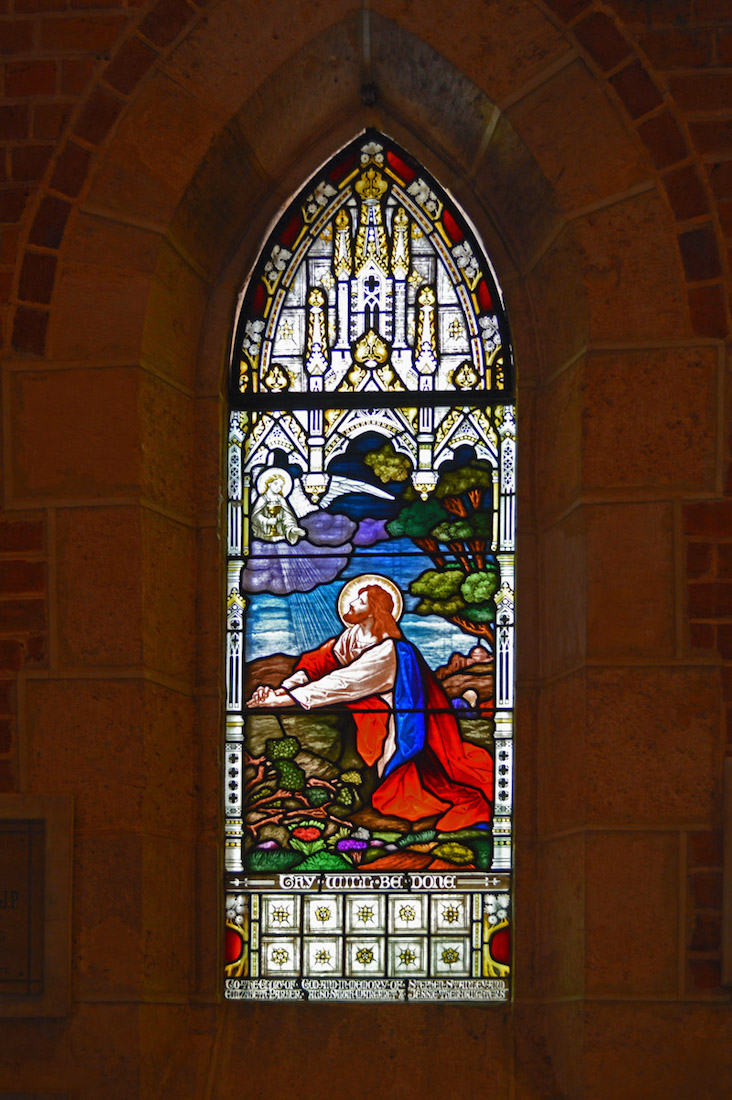
On the West wall of the South transept is another of the stained glass windows in the series, carrying the same pattern at top and bottom. This one depicts Jesus in the Garden of Gethsemane. The inscription below reads ‘Thy will be done’. This window was given in 1915 in memory of Stephen Stanley and Elizabeth Parker, and their daughters Sarah, Margaret and Jessie. It is based on a famous painting of the time. There is a small crypt under the floor of the South transept which contains a Chapel, and is used for the interment of ashes.
23. ICON
Leaving the South transept and turning towards the chancel, we come to the first of two Russian icons dating from the mid-nineteenth century. This one depicts a Madonna and Child.
24. CANTERBURY CROSS
Nearby, we find this Canterbury Cross, given in memory of Major B. K. Pearse who was drowned off the west coast of Ireland in 1934. The Latin inscription is translated as follows: The Cross is a copy of one made, perhaps in Kent, in the eighth century. It is set in stone taken from the walls of Christ Church, Canterbury. As the emblem of salvation and earnest of friendships it was given to this Cathedral by the Friends of Canterbury Cathedral AD 1935. There is a small mystery as to the donor of this Cross, as such crosses were given to all (Anglican) Cathedrals within the Empire and in the USA. They were dedicated by the Archbishop of Canterbury at the Empire Service in Canterbury Cathedral on June 15th 1935.
25. NAVE ALTAR
The nave altar is a focal point of the Cathedral, and stands in front of the Chancel screen. It was made in August 1991 by Robin McArthur, and crafted from Western Australian jarrah. A special feature is the hand-carved knight and dragon portraying the legend of St George. St George was martyred ca 303 and is the patron saint of England. It is said that the dragon terrorized the country, poisoning with its breath all who approached. Every day it was appeased with two sheep, and when these grew scarce, a human victim, chosen by lot. The lot had fallen on the king’s daughter. ...
26. ALTAR DETAIL
... But George attacked the dragon, pierced it with his lance, and led it captive with the prisoner’s girdle. George told the people not to be afraid: if they would believe in Jesus Christ and be baptized, he would rid them of this monster. The king and people agreed; George killed the dragon and 15,000 men were baptized. George asked the king to maintain churches, honour priests, and show compassion to the poor. The legend continues with the sufferings and death of George in the persecution of Diocletian and Maximian, this last point being probably the only historical element in the story.
27. ROOD SCREEN
The chancel screen is a fine ironwork screen which came from England. It was erected in 1906 as a memorial to Perth’s first two bishops (Hale and Parry). The screen was dedicated by Bishop Riley on 1 August 1906. The rood screen was a common feature in medieval church architecture, and served to separate the nave (which was often used for many purposes) from the sanctuary.
28. DEAN’S STALL
On the South side of the chancel, and just inside the chancel screen we find the Dean’s stall. It is a carved and canopied seat fashioned in jarrah timber, and is another memorial to Perth’s first two bishops. The little brass plaque reads ‘Decanus’.
29. CHANCEL ORGAN
In 1994 this chancel organ was installed in the chamber under the bell tower. Consisting of 18 stops in 3 divisions, with mechanical key and electric stop action, this small organ is designed to accompany choirs singing in the chancel. Electric over-ride enables both the chancel and the West organs to be played simultaneously from a third, free-standing console.
30. EAST WINDOW
The beautiful East lancet windows arrived from England in 1889 and were consecrated in November of that year. They were the gift of Sir Frederick Napier Broome (Governor of Western Australia 1883 – 1889) as a memorial to his father who was Rector of Kenley in Shropshire. The windows were made by Clayton and Bell of England and there are ten pictures telling the story of our Lord’s last days from the entry into Jerusalem on Palm Sunday to the Ascension and the coming of the Holy Spirit upon the apostles at Pentecost. The central uppermost window depicts Christ in Glory and matches the equivalent position in the rose window at the West end.
31. HIGH ALTAR
The beautiful carved stone and marble high altar was a gift to the Cathedral from Lady Butler. It was given in memory of Sir Frederick Palgrave Butler, one time Colonial Secretary of Western Australia. Behind the altar there are three panels of white alabaster carved in different degrees of relief. The centrepiece depicting our Lord as a boy in the temple is a near copy of the painting by British artist William Holman Hunt (1790 – 1864), ‘The finding of the Saviour in the temple’. The panels on either side depict Christ cleansing the temple, and Christ and the tribute money.
32. REREDOS DETAIL
The reredos, or carved screen behind the high altar, was designed by W. S. Weatherly, a pupil of Gilbert Scott, and executed in England, and is a gift of the Hon. Septimus Burt KC as a memorial to Sir Archibald Burt, Chief Justice of WA and Louise Emily, his wife, and to Gustavus Edward Cockburn Hare, late Resident Magistrate at Albany and Anne his wife. It was dedicated by Bishop Riley on 22 March 1909.
33. REMEMBRANCE CHAPEL
North of the sanctuary is the Soldiers’ Chapel. Initially a chapter house was to have been built here, but there were insufficient funds. Archbishop Riley and the Chapter conceived the idea of building a memorial chapel, and appealed for funds to all in Western Australia who had lost relatives or friends in the First World War. As a result this chapel was completed in brick and Donnybrook stone. It was consecrated by Archbishop Riley on 7 October 1923. The entry to the chapel from the chancel is surmounted by a beam from the old Stirling Market which was taken over for munitions in the First World War, and is inscribed “Their name liveth for evermore.”
34. CHAPEL ALTAR
Straight ahead is a simple altar with a crucifix behind. To the right on the East wall is the Villers-Bretonneux Cross, fashioned out of wood from the ruins of the shell-shattered church of Blangy-Tronville near Villers-Bretonneux, France. This cross originally marked the common grave of Western Australians of the 51st Battalion killed in the counter-attack on Villers-Bretonneux (24–25 April 1918).
35. CHAPEL MEMORIAL
To our left, on the West wall of the chapel is an illuminated memorial arch with a metal lectern stand, and the words: ‘This chapel is erected to the Glory of God, and in everlasting honour of the Anglican members of the Australian Imperial Force from this State who fought and fell in the Great War 1914–1918.
36. LEAVING THE CHAPEL
Turning even further left we find this exit from the chapel, down several steps. What will we find here?
37. FOUR PROPHETS
Descending several steps from the Soldiers’ Chapel we are faced with a window wall – four stained glass windows showing Old Testament prophets: Isaiah, Jeremiah, Ezekiel and Daniel. These come from the former Church of St Paul, Carr Street, West Perth, which was sold to the Greek Orthodox community, demolished in the 1970s, and replaced by a Greek Orthodox Church. I notice that the Cathedral pamphlet on the windows gives a different history!
38. CRYPT
In front of the four windows, steps lead down to St Saviour’s Chapel. The floor of the Soldier’s Chapel was raised to a higher level than appeared in the original Cathedral plans, leaving space for a storeroom underneath. This area later became St Saviour’s Chapel. Over the years it fell into disrepair, due to dampness affecting the walls. It was restored as a result of a generous gift of thanksgiving for the life of John Robert Pittard, and was dedicated on St George’s Day 1977. The Chapel is normally only open when it is needed for worship. The original screen print behind the altar is a gift of the Friends of St George’s Cathedral. It is called ‘The Tree of Life’, and was consecrated by John Coburn.
39. MADONNA AND CHILD
The Spanish ceramic statue (Madonna) of the Blessed Virgin Mary and the Infant Christ is a gift of the Society of Mary in memory of Bishop John Frewer, second Bishop of North West Australia (1929 – 1965). Nearby are four icons mounted on the Western wall. These represent St John Chrysostum, the Archangel Michael, a Madonna and Child, and St George.
40. NORTH TRANSEPT
We next enter the large North transept, dominated by four lancet windows on the North Wall. The first window on the right depicting Jesus as the Good Shepherd was completed in 1911. For a time, the North Transept was known as the Chapel of the Good Shepherd. Seventy-seven years later, the left window depicting Abel the Good was commissioned and installed. During the 1990s Gerhard Emmerichs completed the windows. He replaced the Gothic tracery with symbolic and decorative stylization of the Tree of Life and the Tree of Knowledge. These representations are depicted as growing out of the architectural roots at the bottom of each lancet. They feature the two great Hebrew figures of Moses and Jacob.


